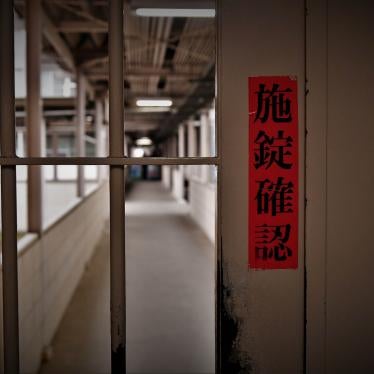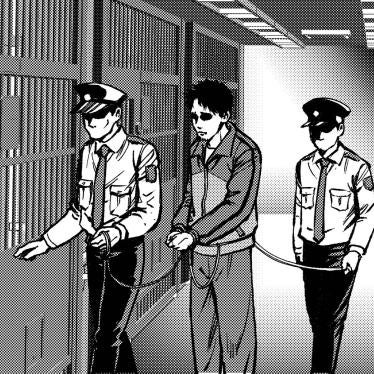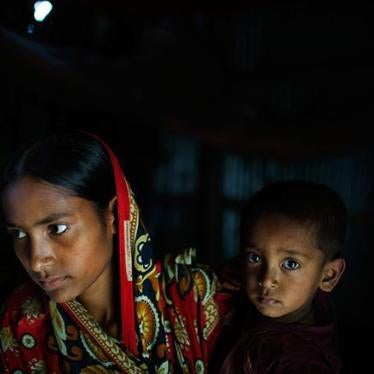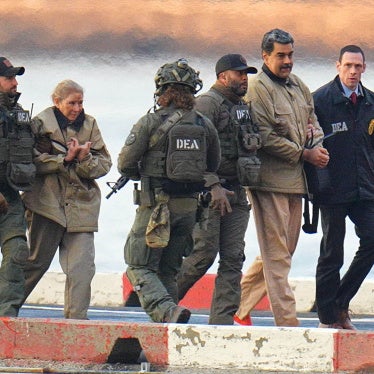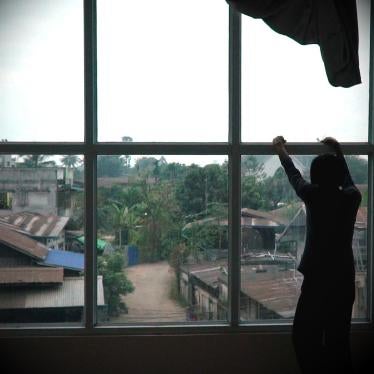(ガザ)イスラエルは、民間人の生命を奪い、財産を破壊する戦時国際法違反の攻撃を停止すべきだと、ヒューマン・ライツ・ウォッチは本日述べた。ヒューマン・ライツ・ウォッチは、イスラエル軍が7月17日にガザ侵攻を始める前に行った、戦時国際法に明白に違反する8件の空爆を検証した。調査結果、ならびに民間人に新たに多数の死者が出たとの報告は、地上戦での民間人の安全に対する懸念を高めるものだ。
イスラエルによる地上戦開始以降、パレスチナ側に200人以上の死者が出ている。国連人道機関の報告によれば、7月7日の戦闘開始以降の死者は500人を超えた。大半はパレスチナの民間人だ。
「イスラエルのミサイル攻撃が海岸にいた少年たちを殺害し、病院とはっきりわかる施設を繰り返し攻撃して以来、地上戦に巻き込まれた民間人の安全への懸念は高まるばかりだ」と、ヒューマン・ライツ・ウォッチ中東・北アフリカ局長代理エリック・ゴールドスタインは述べた。「イスラエルは不法な攻撃の言い逃れに終始するのではなく、攻撃を停止すべきだ。」
ヒューマン・ライツ・ウォッチが調査した攻撃は、男の子4人が死亡、3人が負傷したガザ市内の桟橋へのミサイル攻撃、麻痺を抱えた高齢の患者が入院する病院に数日にわたって繰り返し行われた攻撃、民間家屋やマスコミ関係者の車両であることがはっきりわかるにもかかわらず行われた攻撃、その他これまでに調査報告してきた4つの攻撃である。これらの多く(ただし全部ではない)について、ヒューマン・ライツ・ウォッチは軍事目標を確認できなかった。イスラエル軍が軍事目標に向けて攻撃しないことは戦時国際法に違反する。イスラエル軍は、明らかに民間人とわかる人びと(少年など)や民間施設(病院1件含む)などを意図的もしくは重過失に攻撃している。これらは戦争犯罪を示唆する戦時国際法違反行為だ。
パレスチナ武装組織は、イスラエルの人口密集地域への無差別なロケット攻撃を続けており、戦時国際法に違反している。7月19日、イスラエル南部の町ディモナにある「未公認の」ベドウィン地区にロケット弾1発が落ち、ウーダ・ラフィ・アル=ワジさん(32)が死亡。家族4人が負傷した。7月17日には、別の「未公認」の村にロケット弾1発が着弾。ベドウィンの少女2人が重傷を負った。
7月16日、国連パレスチナ難民救済事業機関(UNRWA)職員は、無人となった学校施設にロケット弾20発が置かれているのを見つけた。UNRWAはただちに砲弾を撤去し、全当事者に通知を行い、未確認のパレスチナ武装組織によるUNRWA関連施設の軍事使用を非難した。パレスチナ武装組織はイスラエルの人口密集地域への不法な攻撃を停止し、民間人に不必要なリスクを強いる場所に部隊や弾薬を配備しないようにすべきだ。
イスラエルは7月11日から17日のうち3日間、航空機と戦車でワファ・リハビリ病院を攻撃。患者と職員4人が負傷した。イスラエルはさまざまなかたちで事前に警告を与えたが、慢性疾患を抱えた麻痺のある高齢患者の(自分で動ける人は1人もいなかった)迅速な移動は不可能であり、もしそうすれば健康状態に深刻な影響が生じた。
戦時国際法は全当事者に対し、傷病者の治療を保証する義務を課している。病院は特別な法的庇護の対象であり、敵に危害を及ぼす行為をなすために使われるときに限って攻撃することが可能だ。イスラエルは、武装組織が病院から100mの地点でロケット弾を発射していたと主張するが、病院を繰り返し攻撃する理由としては不十分だ。警告を行ったからといって、合法な軍事的根拠なしに病院を繰り返し攻撃することの違法性が除去されることはない。イスラエルは誘導ミサイルとともに、戦車砲で病院を攻撃している。これは病院への意図的あるいは重過失な攻撃を示唆するものであり、戦争犯罪である。
7月16日、イスラエルのミサイルがガザ市の桟橋にある小屋に着弾。近くで遊んでいたバクルさん一家の男の子たち4人を殺害した。その直後に着弾したミサイルで、現場から逃れようとしていた漁師1人と子ども3人が負傷した。小屋は「確認されたハマスの施設」なので攻撃を行ったものであり、子ども(10歳から13歳)を「逃走する兵士」と誤認して標的にしたというのがイスラエル軍の言い分だ。イスラエル側は、この施設が合法的な軍事目標である理由を明らかにしなかった。なお「ハマスの施設」は、軍事目的に使われていない限りは軍事目標ではない。特定の軍事目標を狙わない攻撃は不法である。また攻撃側は、攻撃を逃れる人物が戦闘員だと合法的に推定することは許されない。民間人である疑いが残る場合には、その人物を攻撃すべきではない民間人と推定しなければならない。
現場の証拠によれば、攻撃はスパイク・ミサイルで行われた。スパイク・ミサイルには、発射後もオペレーターが標的を確認できるセンサーがついており、標的が明らかに軍関連ではない場合には途中で軌道修正が可能だ。
7月11日のラファでのイスラエルの空爆では、ガンナンさん一家の5人が死亡した。ヒューマン・ライツ・ウォッチは攻撃の3日後にこの家を訪問したが、兵士の展開や武器の貯蔵など軍事目的に利用された痕跡は一切見つけられなかった。地元住民の話によれば、ガンナンさんの拡大家族にはイスラーム戦線(武装部門を持つパレスチナ人組織の一つ)にかかわる者がいたが、この家に住む家族や今回犠牲になった人の中にメンバーはいなかった。ヒューマン・ライツ・ウォッチが確認できる限りで、イスラエルは攻撃理由を説明していない。
7月9日、イスラエルによるモスク近くの繁華街への空爆で、パレスチナのニュース局メディア24の運転手ハメド・シェハブさんが死亡。20人が負傷した。シェハブさんの車には、ボンネットに「TV」と大書してあった。攻撃を受けた時、シェハブさんは同僚のメディア関係者を迎えに行くため、ガザ市南部を走行中だった。同僚の話によれば、シェハブさんは武装組織と無関係だった。ヒューマン・ライツ・ウォッチが確認できる限りで、イスラエル軍はこの攻撃の弁明を行っていない。十分な説明がない以上、攻撃は民間人への不法な攻撃と見られる。攻撃は人の多い街区で行われており、民間人に大きな被害が出ることは予想できた。
イスラエル軍はガザ侵攻の目的を、パレスチナ武装組織が使用するトンネル、ロケット弾、空爆では破壊できない設備を破壊することだと説明している。前回の2008年12月から2009年1月のガザ侵攻では、パレスチナ側の民間人数百人が死亡(多くは不法な空爆および砲撃による犠牲者)し、民間施設が不法に破壊された。この戦闘に関連してイスラエルで訴追されたのは軍人4人のみだ。最高刑はクレジットカード窃盗で7ヶ月半の刑だった。このことは今回の戦闘でも不処罰が続くことを懸念させる。
これ以上の違反行為を防ぎ、責任追及をするため、パレスチナとイスラエルは国際刑事裁判所(ICC)の裁判権を要請すべきだ。同盟国は、戦争法に違反する使用が確認されているか、その十分な疑いがある物資については一切の移送を停止すべきであり、そうした物資への資金提供や支援も停止すべきだと、ヒューマン・ライツ・ウォッチは述べた。第三に、各国は国連人権高等弁務官事務所が公平な調査を目的とする現地調査団を結成し、双方による人権侵害行為をただちに公の場で報告し、全当事者と国連に勧告を行うことを支援すべきだ。
「国際社会が民間人被害の防止を望むなら、ガザへの攻撃が強まる中で起きている戦争犯罪は看過されないことを全当事者にただちに通告すべきだ」と、前出のゴールドスタイン局長代理は述べた。「米国など各国は、パレスチナに対しICCに訴えないよう圧力をかけることを止めるべきだ。これは誤った行動であるだけではない。深刻な人権侵害の事実が多数示されている以上、法による正義の要請に敵対するものだ。」
攻撃の詳細は以下をご覧下さい。
Attack on Wafa Hospital
Israeli forces struck Wafa Hospital, in the Shejai’ya neighborhood, east of Gaza City, on at least three days from July 11 to July 17, 2014. Israeli forces had also shelled the hospital before beginning its ground offensive in December 2008.
Before dawn on July 11, 2014, a possible “warning” missile, which did not explode, hit the hospital’s fourth floor. It was followed later that day by several missile strikes that caused extensive damage. After an attack at about 4 or 5 p.m. the hospital’s director, Dr. Basman al-Ashi, received a phone call from someone speaking “Hebrew-accented Arabic who asked if anyone had been injured in the attack and if we were going to evacuate,” he said. “But we couldn’t evacuate when there is no other hospital in Gaza equipped for our patients.” The hospital’s 17 chronically ill, elderly, and paralyzed patients are immobile.
Photographs of the weapons that struck the hospital on July 11, taken by a foreign volunteer and shown to Human Rights Watch, indicate that several solid-propellant missiles, approximately 170 millimeters in diameter, penetrated the hospital’s stairwell and damaged rooms on an upper floor. Many of the missiles used by Israeli air and ground forces have advanced guidance systems and can be accurately targeted.
On July 15, another phone call urged staff to evacuate by 8 a.m. the following day. That evening, the third floor of the care center for the elderly next to the main building was hit, staff and foreign volunteers told Human Rights Watch. Based on photographs of recovered munitions Human Rights Watch viewed, the remnants appear to be sabots from tank-fired projectiles. Tank fire is line-of-sight, direct fire, and Israeli tanks have accurate targeting systems. The repeated Israeli attacks using accurate missile and tank fire that hit the hospital indicate that Israeli forces targeted the hospital intentionally and not accidentally, Human Rights Watch said.
On the night of July 17, shortly before the ground invasion, a call to the hospital’s receptionist at 9 p.m. warned staff to evacuate immediately. Five minutes later, a strike on a nearby building blew out windows in the hospital and two munitions hit the hospital’s upper floors, causing a fire that filled rooms with smoke, Dr. al-Ashi said. Numerous other strikes hit the hospital shortly thereafter, he said. He and two foreign volunteers told Human Rights Watch that they evacuated while the neighborhood was under attack. Two patients were temporarily disconnected from the oxygen supply they need to breathe, and two patients and two staff were injured, but the extent of their injuries was not known.
Dr. al-Ashi told Human Rights Watch:
At 9 p.m. our receptionist got a phone call from the Israeli military. The soldier told him, “You care about your families, your patients. You need to leave the hospital now, because we will bomb it.” About five minutes later, two missiles hit the fourth floor. They continued shelling the building, and a fire started and we lost our electricity. Our nurses were unable to stand up, there was panic. Some of our patients were choking because they need oxygen and they lost the supply. The rooms were full of smoke. We evacuated all of our patients and staff, but four of them couldn’t get out.
The remaining patients and staff were able to leave later that night for al-Sahaba Medical Complex in Gaza’s middle area. The two foreign volunteers said they helped carry patients down the stairs and that they drove an ambulance with two patients in it while the group was evacuating. “They were still shelling when we drove away,” one of the volunteers said.
An Israeli military spokesperson reportedly told a journalist, “We’ve seen a lot of launches of rockets that came from exactly near the hospital, 100 meters near.” He said that “Obviously the target was not the hospital.” Given the precision weapons available to the Israeli military, a target 100 meters from the hospital provides no justification to hit the hospital. Extensive care should have been taken to avoid any attacks on the hospital.
Moreover, even if military forces misuse a hospital to store weapons or shelter able-bodied combatants, which Israel has not alleged, the attacking force must issue a warning that sets a “reasonable time limit” and can attack only “after such a warning has remained unheeded,” according to the International Committee of the Red Cross study of customary international humanitarian law. According to a media article, the Israeli military’s “News Desk,” a department in the spokesperson’s office, separately confirmed that there were no weapons inside the hospital.
Hospitals have special protections under the laws of war. While other presumptively civilian structures become military objectives if they are being used for a military purpose, hospitals only lose their protection from attack if they are being used, outside their humanitarian function, to commit acts harmful to the enemy. Attacks intended for military targets near a hospital would still need to be conducted in a manner that were not indiscriminate or did not cause disproportionate harm to the hospital or its patients. Israel has not provided enough information about the target to justify such damage to the hospital. Israeli forces repeatedly warned hospital staff to evacuate since July 11, but issuing warnings did not remedy the illegality of repeatedly striking a hospital without a lawful military justification.
Killing of Al-Bakr Cousins
At about 4 p.m. on July 16, an Israeli airstrike hit a small outbuilding on the pier of Gaza City’s port, killing four boys who had been on the pier nearby, journalists reported witnesses as saying. A second strike, less than a minute later, wounded one man and three boys who were about 50 meters from the building and running from the first strike. The strike killed Ismail al-Bakr, 9, and his three cousins, Ahed, 10, Zakariya, 10, and Mohammad, 11 – who had been near the outbuilding. News reports identified the injured man as a fisherman from the Bakr family.
In a July 16 statement, the Israeli military said, “The target of this strike was Hamas terrorist operatives,” and that civilian casualties were “tragic.” A reporter with the Israeli daily Haaretz tweeted that an Israeli military official said at a briefing that the outbuilding was an “identified Hamas installation” and that the second attack had misidentified the children running away as “fleeing fighters.” An Israeli military spokesperson, Lt. Col. Peter Lerner, told journalists on July 18 that the military was investigating the incident.
A number of foreign journalists witnessed the attack, according to their published accounts. One journalist, who asked not to be identified, told Human Rights Watch that she was in her room at the Deira Hotel, about 200 meters from the site of the attack, “when I heard an explosion”:
I ran down to the restaurant, where there’s a big patio overlooking the beach, and I saw a group of small kids running toward the hotel and shouting and waving their arms. Hotel staff were shouting to the kids to take cover, then the second strike hit. There was smoke, and several wounded kids made it to the patio, and at least three others came inside the hotel. I helped treat one of them who had a chest wound caused by shrapnel. He was about 13 years old. I saw another boy, a bit younger, with a head wound. Other journalists and hotel staff went and found the bodies of the other boys on the beach. A colleague of mine followed the three wounded boys to the hospital and said they survived.
Israel has an obligation not to attack presumptively civilian objects, such as an outbuilding on a pier, unless they can reasonably be determined to be a military objective. An attacker cannot lawfully presume that anyone seen fleeing an attack is a combatant, and in cases of doubt must presume the person is a civilian, protected from attack. Attacks that are not directed at a specific military target are unlawful.
Photographs taken by another journalist of shrapnel found at the scene indicate that Israeli forces fired Spike missiles in the attack. Spike missiles, produced by the Israeli arms company Rafael, can be launched from ships, aircraft, or ground forces. The missile has its own camera that allows the operator to observe the target from the moment of firing and to divert the fired missile if last-second doubts arise about the target. If the missile used in this attack was endowed with these visual capabilities, its operators should have been able to differentiate between fighters and young children, and to hold fire if a clear determination of fighters could not be made.
Attack Killing Media Worker Hamed Shehab, Wounding 20
An Israeli airstrike on the afternoon of July 9 killed Hamed Shehab, 32, a driver who had been working for Media24, a local Palestinian news agency, in his car while he was driving in the Rimal neighborhood in southern Gaza City, said a colleague who witnessed the attack. Shehab had purchased the car, a gray Skoda, several years ago, and had affixed “TV” in large letters to the hood.
Shehab had worked occasionally as a driver and assistant for the agency since it opened in October 2013, said the station manager, Khaled el-Ashkar, 34. “He would call us or we would call him when we needed extra help, especially during escalations [in hostilities], when we’re really busy,” el-Ashkar said:
He’d been doing this for many months now. He came to work with us full-time three days before he was killed. That same day he was working for us from 7 a.m. in the hospital, he hadn’t left the hospital all day. He went home to change his clothes because they’d been working for so many hours. I can’t understand why he was targeted. He wasn’t affiliated with Hamas.
A Media24 cameraman, Hatem Salmi, 28, said he had been working with Shehab constantly for the previous three days, and on numerous previous occasions. “He was a good friend, I know he wasn’t with any resistance” groups, Salmi said. On the afternoon of July 9, the station manager called them at the hospital to tell them to go home. They decided to go home to change their clothes, then go to the office. Salmi told Human Rights Watch:
He dropped me off at home, in Rimal [neighborhood], and was supposed to come and pick me up. Hamid was also bringing mattresses so we could sleep in the office. And he had tomatoes and potatoes, for us to break the [Ramadan] fast there too. An hour-and-a-half passed and I called him, and he said, “I am downstairs.” I was looking through the window, and I said, “I don’t see you!” He said was right around the corner, and I saw his car, so I went downstairs to quickly say goodbye to my mother, and then went outside. I took two steps outside and heard the attack.
I ran back inside for cover but I thought the attack was on a nearby neighborhood, I didn’t realize it was right in front of me. My wife shouted, “It’s outside!” so I ran out to check on Hamed. I saw that the car that had “TV” on it, Hamed’s car, had been hit. I looked in the car and I didn’t see anyone, I kept looking for Hamed, I kept asking people around me, “Have you seen the driver?” After a while somebody came and told me that there seems to be a person in the car. I had thought Hamed had run away. Then I went and looked again, and I saw only half of his body. There was no upper body, and his legs were underneath the car. I can’t sleep, now. Every time I close my eyes I see his legs under the car.
The attack wounded 20 people, including children, Salmi, news media, and local rights groups said. Another journalist working at the Media24 offices, Asmaa El Ghoul, provided Human Rights Watch with a video uploaded to the Internet that she said showed the aftermath of the attack, and that closely matched witness descriptions of the strike.
Salmi told Human Rights Watch:
There were kids who had just left the mosque on the ground, the youngest one was 6 years old. Three of my cousins were seriously injured. The youngest of them is around 12 years old, another is 17, and the other is 18. They were evacuated for [medical treatment] in Egypt.
The Israeli military has not stated why it attacked the vehicle, as far as Human Rights Watch has been able to determine. Attacks that are not directed at a military target are unlawful. A civilian vehicle, particularly one marked “TV,” is presumptively a civilian object immune from attack. Even if the target had been a military objective, and even if Shehab were the only person killed, carrying out the attack outside a mosque when the area was full of civilians, including children, would suggest a disproportionate attack and a failure to take steps to minimize civilian loss.
Attack on the Ghannam Home
An Israeli airstrike at about 5:20 a.m. on July 11 apparently targeted the home of Abd el-Razek Ghannam in the Yebna refugee camp, in the southern Gaza Strip city of Rafah. The strike killed Ghannam, 57, his wife, Ghalia, 57, their daughter Wissam, 31, and son Mahmoud, 28. The attack also killed Kifah Deeb, 33, Ghalia’s niece, who had come to stay with the family the previous night because she had been afraid to stay alone during the fighting, neighbors told Human Rights Watch. The only survivor was another son, Hossam, 21, whom a neighbor pulled from the rubble.
Hossam Ghannam, other relatives, and neighbors said that none of the residents of the home were members of any armed group. Abd el-Razek was unemployed and had formerly worked as a construction worker in Israel. Two other daughters, Sumoud, 23, and Nour, 16, had lived in the house but left on July 10 to stay at the home of their married sister, Reem.
Hossam Ghannam told Human Rights Watch that the attack occurred just after he had eaten his pre-dawn, Ramadan breakfast:
My dad and Mahmoud said they were going to pray. My mom told me to go get some sleep. I lay down, then the blast woke me up. I got up to check on my family, then the wall fell on me. I lost consciousness, woke up, and screamed. I remember how much my throat hurt from the dust, and then I lost consciousness again. I woke up in Najjar Hospital.
Hossam Ghannam was later transferred to the European Hospital in Khan Yunis and treated for burns, cuts, and blood loss, then released.
A neighbor, `Aid Ashraf, 20, told Human Rights Watch that the Ghannam home was attacked without warning:
There was no small missile or anything first. Just a huge explosion. I was at home, and for a while I didn’t see anything except dust, then I stepped outside and saw body parts. They were blown to pieces. I found pieces of flesh, hands, legs. Then I found Hossam and dug him out. The only thing that saved him was a mattress and a closet that had fallen on top of him, so they shielded him from the wall that fell on him.
The attack completely destroyed the three-story Ghannam home, which had included a storefront on the ground floor, where Ghalia sold flour, sugar, and other household goods. The explosion badly damaged four nearby houses; neighbors told Human Rights Watch that one was now too dangerous to inhabit.
Human Rights Watch could not determine the target of the attack. Several residents of the area said that some members of the extended Ghannam family, but not any of the residents of the destroyed home, belong to Islamic Jihad, a Palestinian political faction with an armed wing, the al-Quds Brigades. The al-Quds Brigades have claimed responsibility for launching thousands of rockets at Israel. Residents of the area who asked not to be identified said that a relative of Ghalia was related to the wife of a known Islamic Jihad member, named Jihad, whose own home, in a different part of Rafah, had been destroyed in a previous Israeli airstrike. Jihad had received a warning and had survived the attack, residents said. His parents lived in a building near Abd el-Razek Ghannam’s home.
Israel has provided no justification for the attack on the Ghannam home, as far as Human Rights Watch has been able to determine. If its forces struck the house without verifying a military target, the attack was an unlawful attack on a civilian structure. If the house was attacked to punish the Ghannam family for the involvement of relatives in attacks on Israel, it was a form of collective punishment in violation of the laws of war.


